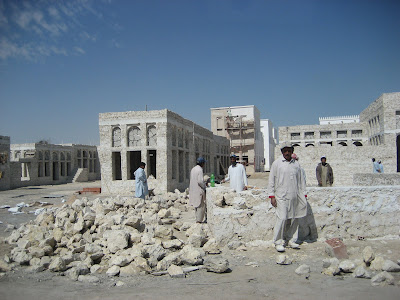1) In emancipated Western society, religious autonomy is a fact, since no human authority has the power to enforce mandatory religious norms. Anyone has the power to opt in or opt out of any religious community. Being Jewish at all, or being any particular flavor of Jewish, is a choice.
2) There isn't any living human to whom I'd be willing to defer as my religious authority.
So autonomy happens by default, in the absence of any authority.
So I identified with something I came across this week from Ramban.
The background: Masechet Ta'anit deals with fasts of all kinds, in various circumstances. These include ta'aniyot tzibbur (communal fasts), which come into existence when they are declared by a beit din, and ta'aniyot yachid (individual fasts), which come into existence when the individual takes them on.
There is a somewhat cryptic statement on Ta'anit 11b and 12b:
אין תענית צבור בבבל אלא תשעה באב בלבד
There are no communal fasts in Bavel except for Tisha B'Av.
The plain meaning of this statement is straightforward, but is contradicted by reality -- we know that they did observe other communal fasts in Bavel! So the commentators go nuts trying to figure out what it really means. Is it referring to fasts in general, or only to fasts for rain (the primary topic of the first half of the masechet)? But if the latter, then why say "except for Tisha B'Av", which has nothing to do with rain? Or is it talking about the details of how the fast is observed (rather than whether it is observed by individuals or the community), equating "communal fasts" with more serious fasts? Does it mean that Tisha B'Av is the only sundown-to-sundown fast in Bavel (note: Yom Kippur is in a whole different league and isn't part of this discussion) and all others are sunrise-to-sundown? Does it mean that some or all of the restrictions beyond eating and drinking aren't observed in Bavel other than on Tisha B'Av? If so, which ones? And anyway, why? If it's just about fasts for rain, then clearly it has to do with Bavel's climate, but if it's about fasts in general, then how is Bavel different?
Here's one answer from the Ramban (as quoted in the Ran):
אין שם תענית ציבור בבבל אלא כל התעניות שמתענין בבבל אינן אלא כתענית יחיד. לפיכך אינו אסור בחומר תענות צבור. והטעם מפני שהדיינין שלהם הדיוטות הם ולא סמוכין ולא היה להם נשיא שתהא גזרתו קיימת על כל ישראל. לפיכך כשהצבור מקבלין תענית צריכין לקבל כולן על עצמן כיחידים שכל אחד מקבל על עצמו, ומשום הכי אינו חייב לנהוג בו אלא כתענית יחיד. אבל בארץ ישראל שהיה להם נשיא, לא היו צריכין לקבל על עצמן לפי שגזירתו קיימת על כולן וכולהו בתריה גרירי.
There are no communal fasts in Bavel; rather, all the fasts that they observe in Bavel are merely individual fasts. Therefore, they are not bound by the stringent prohibitions of a communal fast. And the reason is because their judges are laypeople and do not have semichah (rabbinical ordination)* and they did not have a nasi (president) whose decree would be valid for all Israel. Therefore, when the community accepts a fast, they all have to accept it upon themselves as indivduals, everyone accepting it upon him/herself, and because of this, they only have to behave as on an individual fast. But in the land of Israel where they had a nasi, they would not have to accept it upon themselves, because his decree is valid for all of them and they all follow him.
* He's not talking about what they give out at rabbinical schools nowadays. He's talking about the old kind of semichah, which claims an unbroken chain of succession from Sinai. No one claims this today.
I'm not trying to draw any facile conclusions like "Ramban was really a Reform Jew" or "If Ramban were alive today, he would agree with me about autonomy." These denominational labels mean nothing in a 13th-century context, and our cultural context is different enough that it's hard to draw any conclusions about what he'd say. That's not my point.
My point is that when I read Ramban's description of Bavel, it resonates with me because I think of the world I live in. No one has the power to make a decree that is truly binding on all Israel, and therefore everyone accepts religious practices upon themselves, rather than receiving them automatically as a result of someone else's action. In contrast, some people would like to see our world as more similar to Ramban's description of Eretz Yisrael, where there is indeed a nasi (an individual or an institution) with plenary authority.
I'm not trying to draw any significance from the fact that, in this case, the people of Bavel (who are observing an individual fast) are observing a less stringent practice. One could certainly imagine other cases in which autonomy leads to greater stringency. I'm not arguing here for leniency.
I will reiterate two statements that should be agreed upon by all religious Jews, and which cancel each other out to some degree: 1) the ultimate authority is God, and 2) no living human has the ability to communicate directly with God. This should put to rest any red-herring arguments that this is somehow about human authority vs. divine authority. Of course divine authority would win in such a matchup, but no living human wields divine authority. Therefore, it's really about autonomous human authority vs. heteronomous human authority. And in a world that looks like Ramban's description of Bavel, heteronomous human authority isn't strong enough, and therefore we exercise our autonomous human authority.





















































